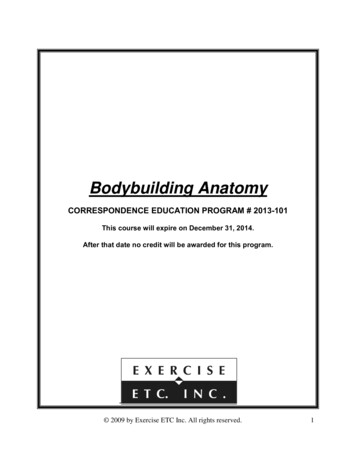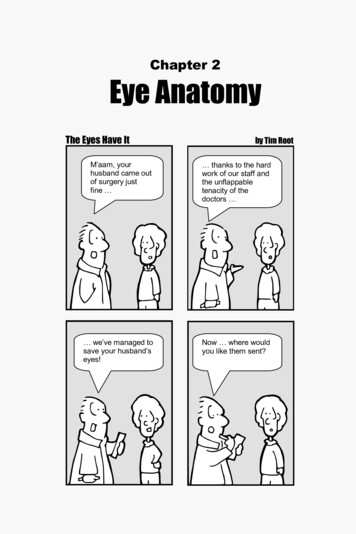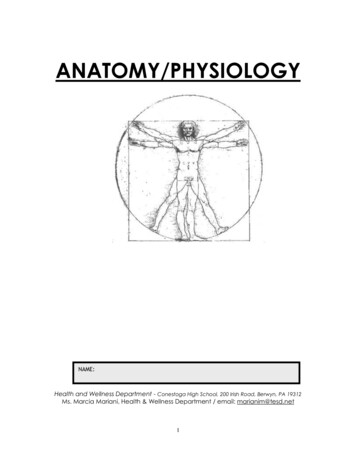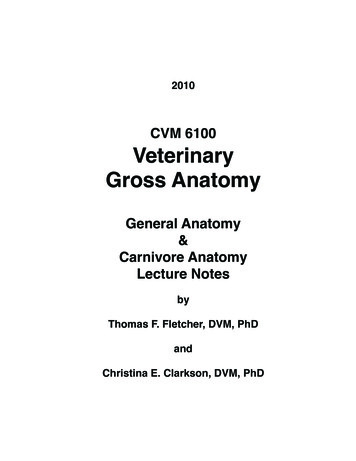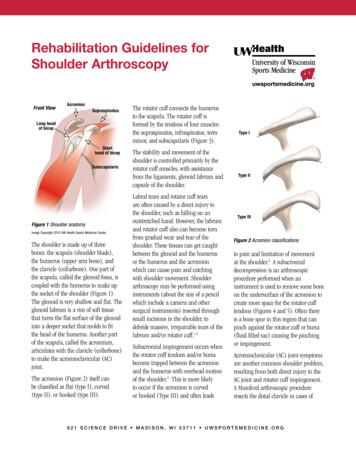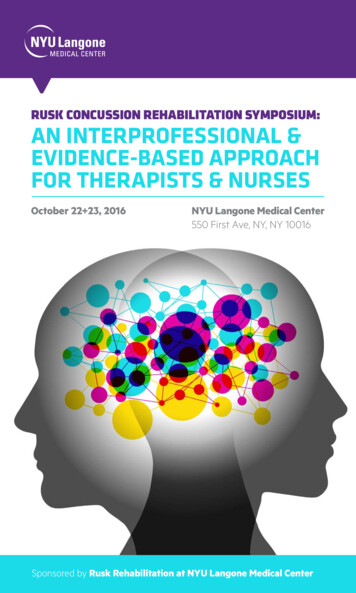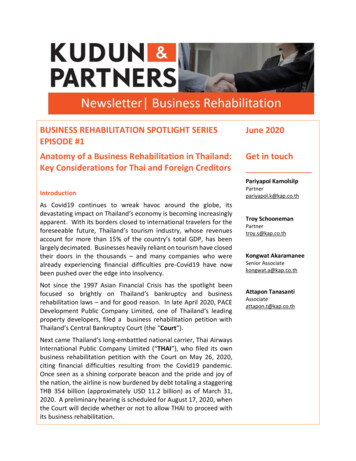
Transcription
BUSINESS REHABILITATION SPOTLIGHT SERIESEPISODE #1June 2020Anatomy of a Business Rehabilitation in Thailand:Key Considerations for Thai and Foreign CreditorsGet in touchPariyapol KamolsilpIntroductionAs Covid19 continues to wreak havoc around the globe, itsdevastating impact on Thailand’s economy is becoming increasinglyapparent. With its borders closed to international travelers for theforeseeable future, Thailand’s tourism industry, whose revenuesaccount for more than 15% of the country’s total GDP, has beenlargely decimated. Businesses heavily reliant on tourism have closedtheir doors in the thousands – and many companies who werealready experiencing financial difficulties pre-Covid19 have nowbeen pushed over the edge into insolvency.Not since the 1997 Asian Financial Crisis has the spotlight beenfocused so brightly on Thailand’s bankruptcy and businessrehabilitation laws – and for good reason. In late April 2020, PACEDevelopment Public Company Limited, one of Thailand’s leadingproperty developers, filed a business rehabilitation petition withThailand’s Central Bankruptcy Court (the “Court”).Next came Thailand’s long-embattled national carrier, Thai AirwaysInternational Public Company Limited (“THAI”), who filed its ownbusiness rehabilitation petition with the Court on May 26, 2020,citing financial difficulties resulting from the Covid19 pandemic.Once seen as a shining corporate beacon and the pride and joy ofthe nation, the airline is now burdened by debt totaling a staggeringTHB 354 billion (approximately USD 11.2 billion) as of March 31,2020. A preliminary hearing is scheduled for August 17, 2020, whenthe Court will decide whether or not to allow THAI to proceed withits business rehabilitation.Partnerpariyapol.k@kap.co.thTroy SchoonemanPartnertroy.s@kap.co.thKongwat AkaramaneeSenior Associatekongwat.a@kap.co.thAttapon TanasantiAssociateattapon.t@kap.co.th
Due to the significance of the Thai Airways case, which is destined tobecome the largest and possibly most talked about businessrehabilitation case in Thailand’s history, and the likelihood that manyother business rehabilitations will follow in the coming years, it is notsurprising that creditor groups are scrambling to appoint legalcounsel in order to protect their interests and to get reacquaintedwith Thailand’s Bankruptcy Act (the “Bankruptcy Act”), the lawwhich governs Thai bankruptcy and business rehabilitationproceedings.This newsletter, which is the first in the series on businessrehabilitation in Thailand, takes readers through the anatomy of atypical business rehabilitation proceeding under the Bankruptcy Actand highlights a number of the key preliminary issues that both Thaiand foreign creditors should be aware of during each stage of thebusiness rehabilitation process.For ease of reference, a diagram illustrating the key milestones andtimeframes associated with a typical rehabilitation proceeding inThailand is shown in Appendix 1.Anatomy Of A Business Rehabilitation ProceedingThe Business Rehabilitation PetitionThe business rehabilitation process in Thailand commences when aninsolvent debtor, one or group of its creditors, or a competentgovernment authority, files a rehabilitation petition in respect ofthat debtor with the Court pursuant to Section 90/3 of theBankruptcy Act (“Rehabilitation Petition”). If the Court accepts theRehabilitation Petition it will set a hearing date to consider whetheror not to allow the debtor to proceed with its rehabilitation and tochoose the person or persons who will prepare the rehabilitationplan (the “Preliminary Court Hearing”). Typically, the PreliminaryCourt Hearing will take place two to three months after the filing ofthe Rehabilitation Petition. By way of illustration, THAI filed itsRehabilitation Petition with the Court on May 26, 2020, and theCourt accepted the THAI’s Rehabilitation Petition on May 27, 2020,setting August 17, 2020, as the date for the Preliminary CourtHearing.The Automatic StayUnder Thai law, an automatic stay is an automatic injunction thathalts certain actions by the creditors to commence or continuetaking action against the debtor or the debtor’s property in order tomaintain the debtor’s ordinary business operations during theKudun and Partners23rd Floor, Unit C and F,Gaysorn Tower 127,Ratchadamri Road,Lumpini, PathumwanBangkok, 10330, Thailandcontact@kap.co.th
rehabilitation process. The automatic stay comes into immediateeffect the moment the Rehabilitation Petition is accepted by theCourt – without the need for any further Court orders – andcontinues until the Rehabilitation Petition is rejected at thePreliminary Court Hearing or otherwise upon completion orabandonment of the rehabilitation process. Under the BankruptcyAct, an automatic stay will generally prohibit creditors from filingnew claims against the debtor and its assets for repayment of debts,from executing existing judgments against the debtor, or from takingactions to enforce security or other collateral. In addition, while anautomatic stay is in effect, creditors are prevented from filingdissolution or bankruptcy proceedings against the debtor.On the flip side, as a protective measure for creditors, an automaticstay imposes significant restrictions on the ability of the debtor todispose of, distribute or transfer its assets, to enter into leasearrangements, to repay existing debts or create new debts, or totake actions which have the effect of creating an encumbrance overthe debtor’s property, unless necessary for the continuation of thedebtor’s normal business operations. Violations of these automaticstay restrictions by a debtor will attract criminal penalties.Key Considerations for CreditorsCreditors should pay particular attention to the restrictions imposedby the automatic stay provisions of the Bankruptcy Act, particularlyin the context of any bilateral debtor discussions, as any agreementsentered into with the debtor which are contrary to or inconsistentwith these restrictions will not be legally binding on the debtor andmay be struck down by the Court as void.Notwithstanding the foregoing general principles, however,creditors should also be aware that the Court has wide-rangingpowers to grant exemptions from the restrictions imposed by theautomatic stay provisions of the Bankruptcy Act. Creditors who wishto take actions otherwise restricted by the automatic stay provisionsof the Bankruptcy Act should consult your legal counsel to determinewhether an application for an exemption could be made to theCourt.
The Preliminary Court HearingAt the Preliminary Court Hearing, the Court will consider twomatters: (1) whether to allow the debtor to proceed with itsproposed business rehabilitation and (2) the appointment of theperson or persons who will prepare the debtor’s rehabilitation plan(the “Plan Preparer”). In deciding whether or not to allow thedebtor to proceed with its business rehabilitation, the Court will takeinto account the matters and apply the legal tests specified in theBankruptcy Act.Creditor ObjectionsCreditors who disagree with the Rehabilitation Petition have theright to challenge it by filing an objection with the Court at leastthree (3) days before the Preliminary Court Hearing. Typically,creditors might object to a Rehabilitation Petition on the groundsthat the debts declared by the debtor are not legitimate, that thereare no reasonable grounds cited by the debtor to justify a businessrehabilitation, or that the debtor has filed the Rehabilitation Petitionin bad faith.If the Court determines that there are reasonable grounds forreorganizing the debtor’s business and that the debtor has filed theRehabilitation Petition in good faith, it will issue an order forrehabilitation. However, if the Court determines that there areinsufficient grounds to justify a business rehabilitation of thedebtor under the Bankruptcy Act, or is of the view that the debtorhas filed the Rehabilitation Petition in bad faith, the Court will issuean order to dismiss the Rehabilitation Petition, in which case theautomatic stay will immediately cease.
Once the Court issues an order for rehabilitation, the Court willconsider the appointment of the Plan Preparer. The Plan Preparercan be the person nominated by the debtor or, if the Court finds suchperson unsuitable, or if the creditors nominate another person to actas Plan Preparer, a creditors’ meeting will be called to consider theappointment of the Plan Preparer.The Debt Repayment ApplicationAfter the Court issues an order for rehabilitation, creditors must filea debt repayment application (“Debt Repayment Application”) withthe Official Receiver within one (1) month from the date that theappointment of the Plan Preparer is published in the Royal Gazette.Creditors should be aware that this one-month period cannot beextended - and the Bankruptcy Act expressly prohibits claims fromcreditors who fail to file their Debt Repayment Application withinthe prescribed one-month period.Key Considerations for CreditorsIt is critical that creditors prepare sufficient documentary evidenceto support their Debt Repayment Application. Foreign creditorsshould also be aware that documents in languages other than Thaimust be accompanied by certified Thai translations. In addition, anydocuments supporting a creditor’s Debt Repayment Applicationmade outside Thailand will need to be legalized, notarized orconsularized before submission to the Court.A creditor’s Debt Repayment Application may be challenged byother creditors, the Plan Preparer, and/or the debtor. If thishappens, an investigation into the validity of the creditor’s claim willbe undertaken and the affected creditor may be required to presentadditional witnesses and/or evidence in support of its DebtRepayment Application. Upon conclusion of the investigation, theOfficial Receiver will issue an order specifying the amount of debtowed to such creditor for the purpose of the rehabilitationproceedings – and such amount of debt thereafter be used tocalculate the voting rights of the relevant creditor in all creditors’meetings relating to the rehabilitation proceedings. Accordingly, itis critical that all creditors – particularly foreign creditors to whomadditional evidentiary and procedural requirements will apply –must consult Thai legal counsel on their Debt RepaymentApplication in order to preserve and protect their rights as creditorsin the rehabilitation proceedings.
The Business Rehabilitation PlanThe Plan Preparer will commence the preparation of the debtor’sproposed rehabilitation plan (the “Proposed Rehabilitation Plan”)after the Court issues its order for the rehabilitation of the debtor.The Plan Preparer will submit the Proposed Rehabilitation Plan to allcreditors and the Official Receiver will call a creditors’ meeting toconsider the Proposed Rehabilitation Plan. Pursuant to Section90/46 of the Bankruptcy Act, the resolution approving the ProposedRehabilitation Plan must be approved by either:1. at a meeting of all creditor groups, by a majority vote, providedthat the total aggregate debts of the creditors voting in favor ofthe resolution is not less than two-thirds of the total aggregatedebts of all creditors present at the meeting; or2. at a meeting of one creditor group, by a majority vote, providedthat (a) the total aggregate debts of the creditors voting in favorof the resolution is not less than two-thirds of the total aggregatedebts of all creditors of that group present at the meeting, and(b) the cumulative amount of debt held by all the creditors whohave approved the Proposed Rehabilitation Plan is not less than50% of the total debt owed by the debtor.Creditor(s) who disagree with the Proposed Rehabilitation Plan areentitled to propose amendments by filing a petition with the OfficialReceiver at least three (3) days prior to the date of the creditors’meeting. If the Proposed Rehabilitation Plan is approved in the
creditors’ meeting and endorsed by the Court, a plan administratorwill be appointed to implement the approved rehabilitation plan andall creditors will be bound by the repayment terms and conditionsspecified therein.Key Considerations for CreditorsCreditors must carefully consider their voting rights and theircreditor groupings, as well as any repayment terms and conditionsspecifically applicable to their creditor group, before casting theirvote in the creditors’ meeting.In the next episode, we will elaborate on the benefits andrestrictions of the automatic stay, an overview of the differentcreditor groups, and the key issues that creditors should insist beincluded in the Proposed Rehabilitation Plan.Note: This article examines a typical rehabilitation proceeding inThailand and is written from a high-level perspective. Please contactus should you have any specific questions regarding your rights as acreditor or debtor in any ongoing or future rehabilitation proceedingsin Thailand.
Appendix 1(Click on image to download)All information, content, and materials contained in or referred to in this article do not, and are not intended to constitute, legal advice and are purely provided for general informational purposes only. For more information, pleasecontact the authors.
Anatomy Of A Business Rehabilitation Proceeding The Business Rehabilitation Petition The business rehabilitation process in Thailand commences when an insolvent debtor, one or group of its creditors, or a competent government authority, files a rehabilitation petition in respect



